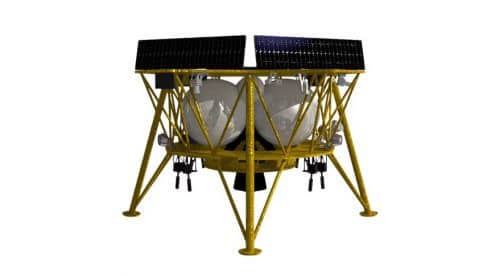The lander will be named Genesis. It will be manufactured by the Firefly company from Austin, Texas, and will be based on the lunar lander technology of the "Bereshit" project produced by the Aerospace Industry. The goal: preparation for landing a man on the moon in 2024

The "Genesis" project, in the framework of which the SpaceIL association attempted to land on the moon, is beginning to bear commercial fruit. Israel Aerospace Industries (IAI) signed an agreement with Firefly Aerospace from Austin, Texas, under which it will help it develop a lunar lander for NASA's Commercial Lunar Payload Services project, based on the technologies developed as part of the Genesis project, in which Israel Aerospace Industries was a key partner.
"This collaboration will allow us to produce an American version of the aerospace industry's historic lunar lander," said Fairfly CEO Dr. Tom Markuzik. "Getting access to the proven technology and expertise of the aerospace industry engineers will help Fairfly occupy a central place in the developing market of improved access to space (Cislunar Marketplace)."
"We provide technological know-how to NASA"
The Director of the Space and Missile Systems Division at the Aerospace Industry, Boaz Lavi, said that the Bershit project placed the Aerospace Industry at the forefront of moon landing technology and allows it to take on additional tasks of landing tools on the moon. "We are proud of the cooperation with Firefly, and the fact that we provide technological knowledge to NASA."
According to the Vice President of Firefly, Shea Faring, through the cooperation with the aerospace industry, Firefly will be the only company participating in the NASA CLPS project, which will be able to provide a platform that has been proven in a space mission. "NASA and the United States will benefit greatly from the development of the next generation of a lunar lander that will be based on the design of Genesis." In the process, he discovered that the lander would receive the nickname Genesis, which means "Genesis" in English.
The lunar lander of the "Bereshit" project at the assembly site at the Aerospace Industry The lunar lander of the "Bereshit" project at the assembly site at the Aerospace Industry
The NASA CLPS project was done as part of NASA's plan to return to landing humans on the moon. NASA's goal is to conduct experiments, measurements and prepare the ground on the moon before the astronauts themselves land in 2024. As part of this program, it has signed agreements with nine space system manufacturers who will compete for the supply of launch services and the supply of the lunar lander for the program. The total scope of the CLPS program is estimated at approximately 2.6 billion dollars for 10 years.
It is interesting to note that in NASA's artist rendering, the future lander with the scientific equipment on board (pictured above) is very similar to the Israeli lander of the Genesis project. A week ago, NASA selected the first probes to be developed for the renewed lunar mission.
Among the items: a tiny and agile space probe that can inspect the area around the lander at a range of up to a kilometer, a camera system that will be installed in the lander and in future vehicles that will travel on the surface of the moon, a demonstration project on a radiation-resistant space computer that can change its configuration according to the mission, measuring equipment, Compact IR camera and more.
The news was published on the TECHTIME website
More of the topic in Hayadan:NASA will award 45 million dollars to 11 companies that will help return man to the moon in 2024
NASA selects the initial commercial lunar landing services for the Artemis program
Genesis 2 mission canceled

3 תגובות
Because until the space launch broke records, a failure of one sensor should not cause disdain for a huge project. Of course, in the case of building a new spaceship, it will be possible to add redundancy, which was not possible this time due to budget limitations.
One attempt at putting and one failure at putting. It's interesting what and why NASA is willing to take a chance on a project that actually failed. I wonder who the person will agree to be the guinea pig for landing himself on the moon. T.N.C.B.H.
This is the added value of "Genesis"